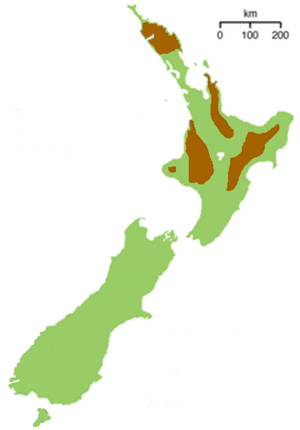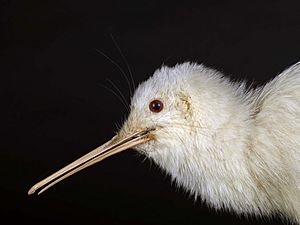North Island brown kiwi facts for kids
Quick facts for kids North Island brown kiwi |
|
|---|---|
 |
|
| North Island brown kiwi, (Apteryx mantelli) | |
| Conservation status | |
| Scientific classification | |
| Genus: |
Apteryx
|
| Species: |
mantelli
|
 |
|
| The distribution of North Island brown kiwi | |
| Synonyms | |
|
|
The North Island brown kiwi (Apteryx mantelli) is a special type of kiwi bird. It lives all over the northern part of the North Island in New Zealand. With about 35,000 of them left, it is the most common kiwi species. This amazing bird holds a world record for laying the biggest eggs compared to its body size!
Contents
Discovering Kiwi Species
For a long time, scientists thought the brown kiwi (then called Apteryx australis) included other kiwi types like the rowi and the tokoeka. But around the year 2000, scientists used genetic tests to look closely at the DNA of these birds. They found out that the tokoeka was actually its own separate species. So, the brown kiwi got a new scientific name: Apteryx mantelli.
Soon after, in 1998, more genetic tests showed that the rowi was also a unique species, named Apteryx rowi. These tests help us understand how different animal families are related.
Rare White Kiwi
In 2004, a special kiwi was found. It had white streaks around its head. Scientists at Massey University figured out that this was a very rare genetic change, sometimes called a partial albino. There are only a few records of such a kiwi, including an old painting and a museum sample. The injured bird got better and joined a special breeding program to help protect its kind.
The North Island brown kiwi was first described by Abraham Dee Bartlett in 1813.
Where Kiwis Live
Brown kiwis live all over the North Island of New Zealand. You can find them in places like Northland, Coromandel, and the Whanganui Region. They are very tough birds and can live in many different places. They have learned to live on old farmland, in pine tree forests (which were brought to New Zealand by people), and in their natural native forests. They especially like thick, warm, and mild forests.
What Kiwis Look Like
Female North Island brown kiwis are about 40 cm (16 in) tall. They weigh around 2.8 kg (6.2 lb). Males are a bit smaller, weighing about 2.2 kg (4.9 lb). Their feathers are spiky and streaky, with a reddish-brown color. The North Island brown kiwi is the only type of kiwi that you can see in zoos around the world.
Kiwi Behavior and Life Cycle
Like all kiwis, these birds mainly eat insects and other small creatures without backbones. They usually have 2 or 3 groups of eggs, called clutches, each year. Each clutch has 2 eggs.
When kiwi chicks hatch, they already have all their feathers. They are also very precocial, which means they can leave the nest and find food for themselves within just one week! This is different from many other birds whose babies need a lot of care from their parents.
Protecting the Kiwi
The North Island brown kiwi is listed as a Vulnerable animal by the IUCN Red List. This means it is at risk of disappearing if we don't protect it. The biggest danger to these kiwis comes from predators like dogs, cats, and stoats (a type of weasel).
Sadly, in areas where these pests are not controlled, about 94% of kiwi chicks die before they are old enough to have their own babies. In 2000, there were about 35,000 North Island brown kiwis.
Studies across New Zealand show that, on average, only 5 out of every 100 kiwi chicks survive to become adults. However, in places where people are actively controlling pests, many more North Island brown kiwi chicks survive. For example, in Tongariro Forest, after a special pest control effort in 2006, 57% of the kiwi chicks survived to adulthood. Because of ongoing pest control, the number of adult kiwis in Tongariro has almost doubled since 1998! This shows that our efforts to protect them are working.
See also
 In Spanish: Kiwi marrón de la Isla Norte para niños
In Spanish: Kiwi marrón de la Isla Norte para niños




